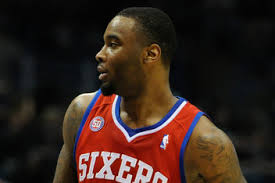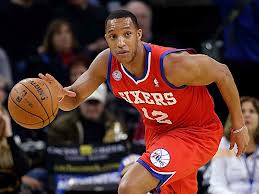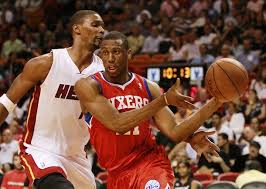Wiggins-Parker-Randle
Liberty Ballers posted a great rundown of last nights college action which highlighted picks 1, 2, and 3 in the 2014 NBA Draft: Andrew Wiggins, Julius Randle and Jabari Parker. Good read. [Liberty Ballers]
How do the Sixers Fare According to Advanced Stats?: Part 2
We looked at Player Efficiency Rating in the first installment of this series of posts. You can read that here.
We learned that Thaddeus Young was the most efficient player on the team, but where did he and other players on the current roster fare as far as other metrics go?
Effective Field Goal %:
Again, this measures a player’s shooting percentage based on shots made adjusted for three point shots, as well as all other field goals made. Three point shots made are adjusted not based on how many were made against how many were missed. The stat also takes into account that three point shots count for one more point than lay ups, dunks and all other shots taken inside the three point line. In this catagory the winner is:
Arnett Moultrie .582
The Sixers’ top five in this category were:
Moultrie .582
Royal Ivey .559
Thaddeus Young .532
Dorrell Wright .508
Shelvin Mack .500
Mack played in only 4 games last season, so when we throw him out of we end up with
Jason Richardson .487
Of those players, only Moultrie and Young remain on the active roster. How did it come to this? Let’s take a look.
Molutrie, Ivey, Mack and Richardson saw limited minutes for most of the 2012-13 season. Wright was brought in to be a scoring threat and has been considered one of the better shooters in the league over the past five years. Young takes mostly high percentage shots and spends a lot of time playing near the basket as does Moultrie, when he plays.
We already have seen that Young, Moultrie and Wright were three of the team’s most efficient players last season, so it makes sense that they would have high Effective Field Goal numbers.
Molutrie’s Traditional Field Goal % last season was .582. Because he took no 3 point shots at all last season, his shooting % did not need to be adjusted at all.
Royal Ivey has been known as an ok 3pt shooter throughout his career. He did not play much and on higher % shots came out with a .431 shooting %. However, he shot .420 on three pointers, a very high 3pt %. He made 37 three pointers last season, which accounted for 37 more points to add to the 124 points he scored (on 62 makes) inside the 3 point line.
Young shot .538 (509 of 958), but hit only one 3 point shot all season. The good news for him was, he attempted only 8 of them for a .125, which did cause his % to be adjusted down, but not enough to really change his eFG%
Dorell Wright shot .396 (237 of 599), very poor for a good shooter, so how did his adjust up? On 3 pt shots he shot .374 (135 of 361) which again, is a very good number.
Finally, because Mack played in only 4 games we look at Jason Richardson. J-Rich was shooting at a clip of .402 at the time of his injury last season. He also shot .341, so his was adjusted because he shot a high 3pt.
Who were the bottom five players in eFGP%?
For the purpose of this article, let’s throw out Justin Holliday, Jeremy Pargo, Charles Jenkins and Maalik Wayns who played in a total of 56 games between the four of them.
Here’s what we have:
Nick Young .482
Jrue Holiday .466
Kwame Brown .459
Lavoy Allen .454
Evan Turner .446
Allen had a bad year last season, this is well-documented. Nick Young was a gun who never saw a shot he didn’t like and thought he was a 3pt specialist. Brown sucks, and Holiday had to carry the load of the offense often last season. This leaves us with Evan Turner.
Turner was 9th on the team in PER, so it makes sense that his eFG% was low. He shot .419 (441 of 1053) with a .365 3pt % (58 of 159). We will see as we dive into these stats, Turner is not an effective player. He is still young and can become one, but right now, he has the most glaring weaknesses of any full-time player on the team.
Compare Turner to other starting SF in the East from last season and here is what we see:
Kyle Korver (Hawks) .618
Lebron James (Heat) .603
C.J. Miles (Cavs) .518
Paul Pierce (Celtics) .502
Carmelo Anthony (Knicks) .502
Paul George (Pacers) .491
Kyle Singler (Pistons) .483
Aaron Affalo (Magic) .478
Luol Deng (Bulls) .461
Michael Kidd-Gilchrist (Bobcats) .460
Rudy Gay (Raptors) .449
Gerald Wallace (Nets) .448
Evan Turner (Sixers) .446
Chris Singleton (Wizards) .442
Luc Mbah a Moute (Bucks) .418
Of those players at the bottom, Singleton was a rookie, Wallace’s best days are behind him and Mbah a Moute is a player who left college before he was developed and has struggled to find a foothold in the NBA. Another interesting name near the bottom of that list is Rudy Gay.
Gay played most of last season with the Memphis Grizzlies who employ statistics guru John Hollinger in their front office. When Gay was traded people didn’t get it, they saw a multi-talented player who has always been one step away from being a star. Gay is a good scorer, but takes and misses too many shots in a game. The Grizzlies’ offense changed once
Gay was gone, and coach Lionel Hollins, who had been resistant to Hollinger’s analysis-driven advice was been replaced after the season. Is Evan Turner soon to be in the same boat as Gay? We’ll see.
How Do The Sixers Fare According to Advanced Stats? Part 1
Yesterday we published an overview of some of the metrics most commonly used by people outside of the NBA’s inner circle. Today we are going to begin to take a look at how the Sixers fared last season and how they are projected to fare this season based on both metric and traditional stats, courtesy of Basketball Reference.
Who was the team’s leader in PER during the 2012-13 season?
With a total PER of 18.2, the winner was Thaddeus Young.
We’ve already established that 15.00 is the league’s average for PER. Only five players on the team were able to eclipse that number.
Thaddeus Young 18.2
Jrue Holiday 16.7
Arnett Moultrie 16.7
Dorell Wright 16.0
Spencer Hawes 16.0
(It should be noted that Moultre played in only 47 games, and played nearly 2100 minutes fewer than Young. That said, he was effective when he was on the court.)
Who wasn’t effective, other than the rest of the team? Evan Turner for one. He posted a PER of just 12.1, which was the lowest of any starter and the second lowest among players who played 1500 or more minutes (Only Lavoy Allen had a lower PER among those players with an 11.5). The Sixers dressed seventeen players last season, eleven of them posted a PER which was below the league average.
Where did Young fare as far as the rest of the league? Looking at the 2012-13 leaders in PER we find this:
Lebron James 31.59
Kevin Durant 28.29
Chris Paul 26.38
Carmelo Anthony 24.75
Brook Lopez 24.73
Tim Duncan 24.38
Dwayne Wade 23.96
Russell Westbrook 23.92
Tony Parker 23.03
Kobe Bryant 23.02
If we were to keep ranking players, Young falls well out of the top 20. Young was an effective player, but no more than that. The problem with the team, according to these stats is that only five players were above average. Of those five, two, Dorell Wright and Moultre were essentially part-timers, with Wright playing more than Moultre.
Here are some players on playoff teams that Young’s PER compared to
Serge Ibaka (Thunder) 19.4
Jordan Hill (Lakers) 18.5
Larry Sanders (Bucks) 18.7
Tiago Splitter (Spurs) 18.7
Marc Gasol (Grizzlies) 18.7
Joakim Noah (Bulls) 18.1
Look at that list, are any of those players stars? Gasol is probably the best of that group, but for the most part they are complementary players on their respective teams. When your best player is a complementary player your team is in trouble.
There is also something else that should come out of this conversation: why did Arnett Moultire spend so much time on the Sixers’ bench? He was effective when he played, anyone with two eyes could see that. He was a rookie on a bad team, and played more efficiently than all but two players on the team. Was this team filled with so much talent that he ended up buried, or did Doug Collins just decide that, once again, he wasn’t in the mood to let a player grow?
PER allows for tracking over the course of a player’s career, and is a good indicator of how players will perform in a season. The Sixers’ top five career PERs are
Thaddeus Young 16.8
Arnett Moultrie 16.7
Jason Richardson 16.3
Spencer Hawes 14.1
Kwame Brown 12.5
That’s right, Kwame Brown is fifth. Worried yet?




Recent Comments